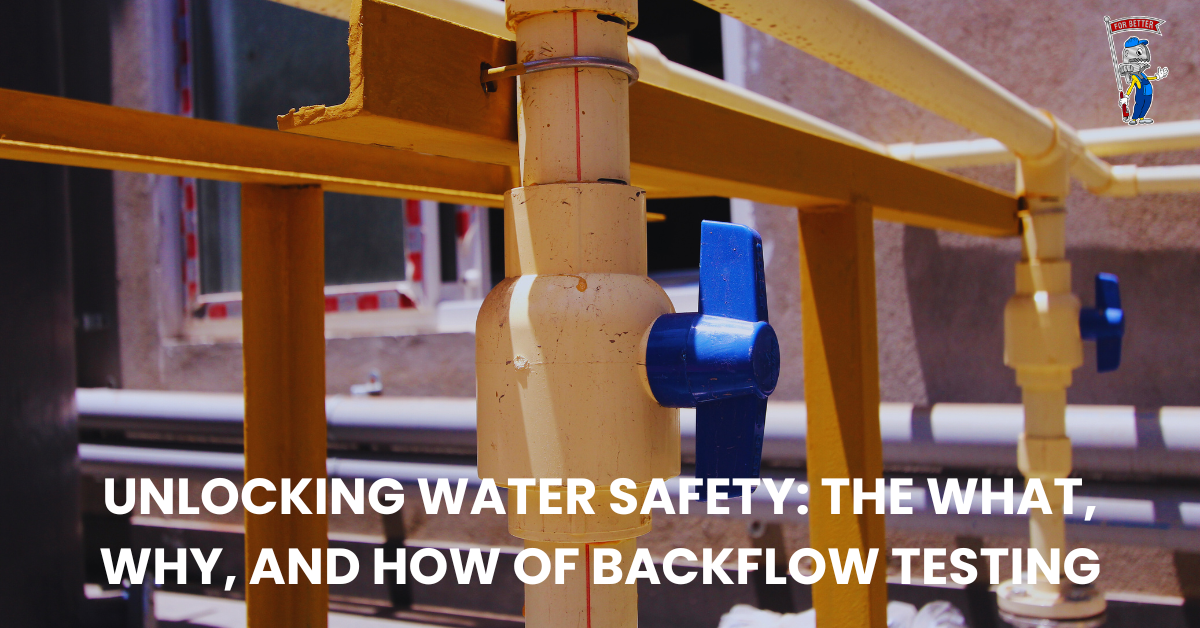What does backflow mean?
Before discussing the backflow testing, we will talk about what backflow is. When it’s about home plumbing or fire protection systems, then water should flow to your property, but when water flows away from the property, that’s backflow. Backflow is dangerous because, further, it can turn into a pollutant. Contaminants can easily reach water and make it unsafe.
Backflow is when contaminated water has reversed flow and meets with the clean water line. Backflow can occur in the cross-connection between dirty and clean water and cause changes in water pressure that further lead to water bursts. Dirty water contains hazardous materials like chemicals, pesticides, and chemicals, which can lead to serious health concerns.
When dealing with a fire protection system, backflow is common because the water sprays all over. This is when you need a backflow preventer system to keep H2O flowing in only one direction. Well, the process is not as easy as it sounds. You must test these devices also to ensure they are working smoothly.
How to prevent backflow?
Backflow prevention is necessary, and it requires effort from both the water supplier and the consumer. To prevent backflow, you need to follow certain strategies like minimizing the cross-connections and keeping track of potentially hazardous connections. It could be better if you install, maintain, and test the backflow prevention tools. The bulk of prevention strategies followed by customers mostly focus on prevention mechanisms.
Backflow prevention strategies focus on minimizing the changes in the flow direction because of pressure differences. Depending on the backflow type, you need to track some parts like check valves, relief valves, and air inlet valves. Do you know why backflow testing is required?
Annual testing requires tracking the wear and tear of valves. Testing should also be carried out if there is a chance of misalignment. During the testing procedure, repairing, new installations, relocation, and prevention assemblies are tested to ensure the valve seats and seals are aligned and not clogged by debris.
- In multiple areas, the testing should be done by certified professionals. Well, individuals can also perform this, but it requires calibrated equipment & different testing protocols for different preventive assemblies.
- During the backflow testing procedure, water services must be turned off. Even if there is water in the line, it can’t be used until the testing is done so that the water pressure does not reach zero.
- Anyone who requires water services constantly must have multiple prevention tools in parallel. Backflow prevention at fixtures allows testing to occur without completely shutting off the water.
Where are Backflow preventers used?
Backflow preventers are associated with the fire protection system. Well, residential plumbing systems use them as well. The system prevents contaminants from making their way into the water supply. Backflow preventers ensure that the water is safe to drink. Along with fire protection and residential plumbing, irrigation also utilizes backflow preventers.
Let’s try to understand with an example: if the water you use to feed the plant is full of contaminants, then plants will never grow properly. This is the reason why it is required to test the backflow prevention to ensure that your plants are healthy.
To prevent backflow, a safety device has to be installed. When you install this system, it prevents backflow from occurring. If the device notices any changes in water pressure, the device starts stopping dirty water from flowing with the clean water supply. However, the device must be installed properly and tested to ensure that the clean water lines remain free of contaminants. The devices also require annual testing to ensure that they are functioning properly. This is all you should know about what is backflow testing.
The backflow test defines that the backflow preventers ensure they are working properly. Testing backflow preventers regularly assures that they will work at emergency costs. Every backflow preventer tool should have the specific dates marked on it, which indicates when they are required to be properly tested. Now you know what backflow testing is so now move to understand why backflow testing is required-
1.) Health concerns
The major goal of backflow testing is health concerns. When water starts flowing backward, the debris and harmful contaminants present in the sewer system can make it polluted. It will be really dangerous because you might end up drinking polluted water that causes risk to your health.
2.) Eliminate the chances of building damage
Backflow prevention tools also stop buildings from getting damaged. When H2O travels backward, there is a chance that it will bump into the walls. The corrosion can lead to multiple damages over time. When water continuously hits the same spot, the wall will crumble. It can damage the structural integrity of your building. So, if you want to maintain the structural integrity of your building, then test the backflow prevention.
3.) Concerns related to the environment
Polluted water is not good for the environment. If the contaminants are allowed back into the water supply, they will re-enter the environment. The contaminated water goes back to the sewer and eventually makes its way to the lakes and oceans. This is the major reason to test the backflow preventer regularly. We all know the lakes and oceans are contaminated enough, so there is no need to make them more polluted.
4.) Community reasons
Backflow prevention is necessary to create a healthy community. If you want to see a healthy and prosperous community, then you need to be responsible for the clean water flow system. Buildings may fall apart, and the community may get sick because of excessive moisture present in the water. This is why it is recommended to perform backflow prevention testing before it takes a bigger and more hazardous form. Cities that don’t take this practice seriously can receive fines from governments.
Choose plumbing professionals who have tester certification because it assures the individual knows when to follow specific procedures & how to measure the results. They are responsible for making small repairs & identifying the errors in the assemblies and rectifying them.
We take pride in safeguarding your water supply. With over a decade of industry experience, our dedicated team is committed to ensuring the purity and integrity of your water systems. We understand the critical role clean and uncontaminated water plays in your daily life, whether at home or in your business. Call us now at Fairfax +1 (703)-250-4200, Arlington +1 (703)-524-1250.
How to book a backflow test?
Whether it’s a business or a home, multiple state regulations require a backflow test that should be performed annually. The backflow test report is sent along with the letter from the city the month before it is due. Once you receive the notice, you should contact a licensed plumber. Contact Us today and we will help you with the proper backflow testing. After being certified and tested by our professionals, the report should be filed back to the city. Check how is a backflow test performed.
Permission is required before the backflow testing is performed
Before the test starts, licensed plumbers must follow the following responsibilities-
- The licensed plumber should have permission from the owner and property representatives to shut the water flow off. The authorities should be notified beforehand.
- Track and record the device assembly condition.
- Verifying the model, serial number, manufacturer, and location/size of the device.
How is backflow testing performed?
When all the formalities mentioned above are done, the actual testing procedure begins. The testing procedure involves utilizing valves on the backflow testing tool, known as relief valves & gates. During the process, the plumbers check for whether the valves are closed or not, the movement of the gauge, and water leaks. Certain criteria required to be met during the testing process-
- Ensure the check valves avoid backflow.
- It should be ensured that the airports open when they should be
- The relief valves should open before the pressure between the check valves is less than 2 PSL below the pressure of the inlet device.
By following the above-discussed things, I hope you understand what is backflow testing and when/why it should be performed. To perform this in your place, hire a professional plumber near your location. We provide professional Plumbing & Backflow services in Northern Virginia. Make a call to us & book your appointment now.
Frequently Asked Questions
What should testers look for during backflow testing?
During the process, the tester identifies the valve type, the direction of water flow, and overall function. Based on the backflow mechanisms type, different procedures, and gauges types are required. If the test cocks are not a part of the assembly, the testers will attach them wherever it is required.
What are the major things property owners should do to ease the process?
There are no such major things that property owners need to do for preparing the backflow test. The process can be quickly done if everyone involved in this knows the water will shut off for a while and makes alternative plans for water use.
Why is annual backflow testing required?
Annual or scheduled testing is necessary; otherwise, you will be fined, or the water supply to the property might be cut off. The goal of backflow prevention testing is to keep the portable water system clean. It’s our responsibility to clean water, and backflow testing helps people to meet any plumbing and building codes.



